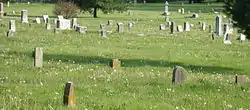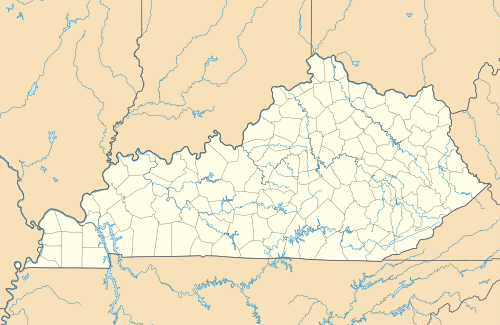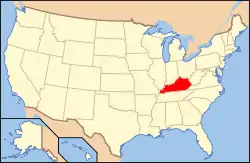African Cemetery No. 2 (Lexington, Kentucky)
African Cemetery No. 2, also known as The Cemetery of the Union Benevolent Society No. 2, is a historic burial site located in Lexington, Kentucky, United States.[2]
African Cemetery No. 2 | |
 African Cemetery No. 2 | |
  | |
| Location | Lexington, Kentucky |
|---|---|
| Coordinates | 38°3′00.5″N 84°28′41″W |
| Area | 7.7 acres (3.1 ha) |
| NRHP reference No. | 04000245[1] |
| Added to NRHP | March 31, 2004 |
Founding and history
The first burials occurred on the property as early as the 1820s. The Colored Peoples Union Benevolent Society No. 2 purchased the property for use as a cemetery in 1869. The last burials in the cemetery took place in 1974.[2]
In 1889, 300 bodies were moved from the Presbyterian Cemetery on Limestone Street to African Cemetery No. 2 under the supervision of C. O. H. Thomas.[3][4]
In 1973, Lexington city government took control of the cemetery.[5] In 1979, the African Cemetery No. 2, Incorporated was organized to save the cemetery.[6]
In June 2003, a Kentucky Historical Highway Marker was placed on the site.[6] The cemetery was added to the National Register of Historic Places on March 31, 2004.[1]
Burials

The 7.7 acre (3.1 ha) cemetery contains over 5,000 graves, of which 1,200 are identified with less than 600 being recognized with markers.[2]
Military veterans graves total 148, with 112 being U.S. Colored Troops of the American Civil War.[7] About 80 of those veterans trained at nearby Camp Nelson, a Union supply depot and recruitment site. Of Kentucky’s almost 24,000 U.S. Colored Troops, 10,000 trained at Camp Nelson.[8][9] In addition to Kentucky, states represented among civil war veterans are New York, Massachusetts, Arkansas, and Tennessee.
Since 2005, Juneteenth Jubilee has been celebrated annually honoring Civil War veterans. An American flag is placed on each grave and every name is read aloud.[10][11]
Veterans are also interred from the Buffalo Soldiers/Spanish-American War, 12; World War I, 18; and World War II, 4.[10]
Clarence Espy was one of the soldiers who served with the 369th Infantry, the regiment which became known as the "Harlem Hell Fighters". Espy, a native of Lexington, was awarded the Croix de Guerre, France's highest military honor.[12]
R. C. O. Benjamin, a journalist and an attorney, was murdered on October 2, 1900 during an altercation involving voting rights for African Americans.[13] In 1910, a monument was dedicated at his grave site.[13]
Over 150 graves are of those who worked in the equine occupations-trainers, jockeys, foremen, stablehands, and grooms. The range of birthdates, 1842 to 1897, and the dates of death, 1890 to 1932, indicates the prominence of African-Americans in a thriving horse and racing industry. Birthdates before 1866, show the likelihood that eight people were born enslaved.[10]
Thoroughbred Racing Hall of Fame jockey, Isaac Burns Murphy, born 1861, was originally buried in African Cemetery No. 2.[14] Murphy, the first jockey to win three Kentucky Derbys,[15] died February 12, 1896 of pneumonia. In 1967, his remains were moved to the Man o' War gravesite off Russell Cave Road, and were moved again in 1987 to the Kentucky Horse Park.[14]
The International Museum of the Horse, located at the Kentucky Horse Park, is collaborating with cemetery volunteers in creation of the Chronicle of African-Americans in the Horse Industry. This interactive educational website tells story of African-Americans and the role they played, and still play, in the horse industry.[16] The museum also has a permanent exhibit, Black Horsemen of the Kentucky Turf, to celebrate the forgotten contributions of African Americans to the horse industry in Kentucky. Some of those featured in the exhibit are interred at the cemetery.[17]
A documentary created by the cemetery’s volunteer organization in conjunction with the Lexington Public Library is available at this link.[18]
A cemetery map which notes individuals and sections is available here.[19]
Restoration
On April 4, 2002, volunteers from Canine Solutions International searched, mapped, and studied the physical grounds of the cemetery.[2]
The approach to preserving the cemetery grave stones was the subject of a paper by M. Riegerta and A. Turkington. The paper published in Building and Environment discusses the "scientific knowledge of decay processes with conservation theory and the needs of stakeholders".[20]
See also
References
- Notes
- "National Register Information System". National Register of Historic Places. National Park Service. July 9, 2010.
- "African Cemetery No. 2". University of Kentucky. 2008-04-27.
- "Removing The Dead". The Kentucky Leader. University of Kentucky. 1889-05-20.
- "Injunction Granted". The Kentucky Leader. University of Kentucky. 1889-05-22.
- "City Approves Ordinances On Cemetery". The Lexington Leader. University of Kentucky. 1973-04-19.
- "African Cemetery No. 2". Isaac Scott Hathaway Museum. Isaac Scott Hathaway Museum, Inc. Archived from the original on 2011-07-19. Retrieved 2009-07-23.
- "Notable Kentucky African Americans Database". University of Kentucky Libraries. University of Kentucky. 2008-04-28.
- "Presidential Proclamation on the Establishment of the Camp Nelson National Monument". The White House. Retrieved 2019-06-17.
- Nicholasville, Mailing Address: 6614 Old Danville Road Loop 2; Us, KY 40356 Phone:881-5716 Contact. "Camp Nelson National Monument (U.S. National Park Service)". www.nps.gov. Retrieved 2019-06-17.
- "historical profiles". Mysite. Retrieved 2019-06-17.
- By. "'They fought for our freedom.' Juneteenth service honors black Civil War veterans". kentucky. Retrieved 2019-06-17.
- "Annual Reports". 2006. Hathaway Museum. 2008-04-27. Archived from the original on 2008-07-06. Retrieved 2008-04-29.
- "Annual Reports". 2006. Hathaway Museum. 2008-04-27. Archived from the original on 2011-10-02. Retrieved 2009-07-23.
- "African Cemetery No. 2 walking tour". African Cemetery No. 2. University of Kentucky. 2008-04-27.
- "Isaac B. Murphy". Hall of Fame: Jockey's. National Museum of Racing and Hall of Fame. 2004. Archived from the original on May 10, 2008. Retrieved 2009-07-23.
- "The Chronicle of African Americans in the Horse Industry". International Museum of the Horse. Retrieved 2019-06-20.
- "Home". International Museum of the Horse. Retrieved 2019-06-20.
- lexlibrary (2012-03-12), Eight Acres of History: Lexington's African Cemetery No. 2, retrieved 2019-06-20
- "A Walking Tour". www.uky.edu. Retrieved 2019-06-17.
- Building Stone Decay: Observations, Experiments and Modeling
External links
| Wikimedia Commons has media related to African Cemetery No. 2. |
- African Cemetery No. 2 web site
- http://www.findagrave.com/cgi-bin/fg.cgi?page=cr&CRid=2266490&CScntry=4&CSst=19&CScnty=1022&

